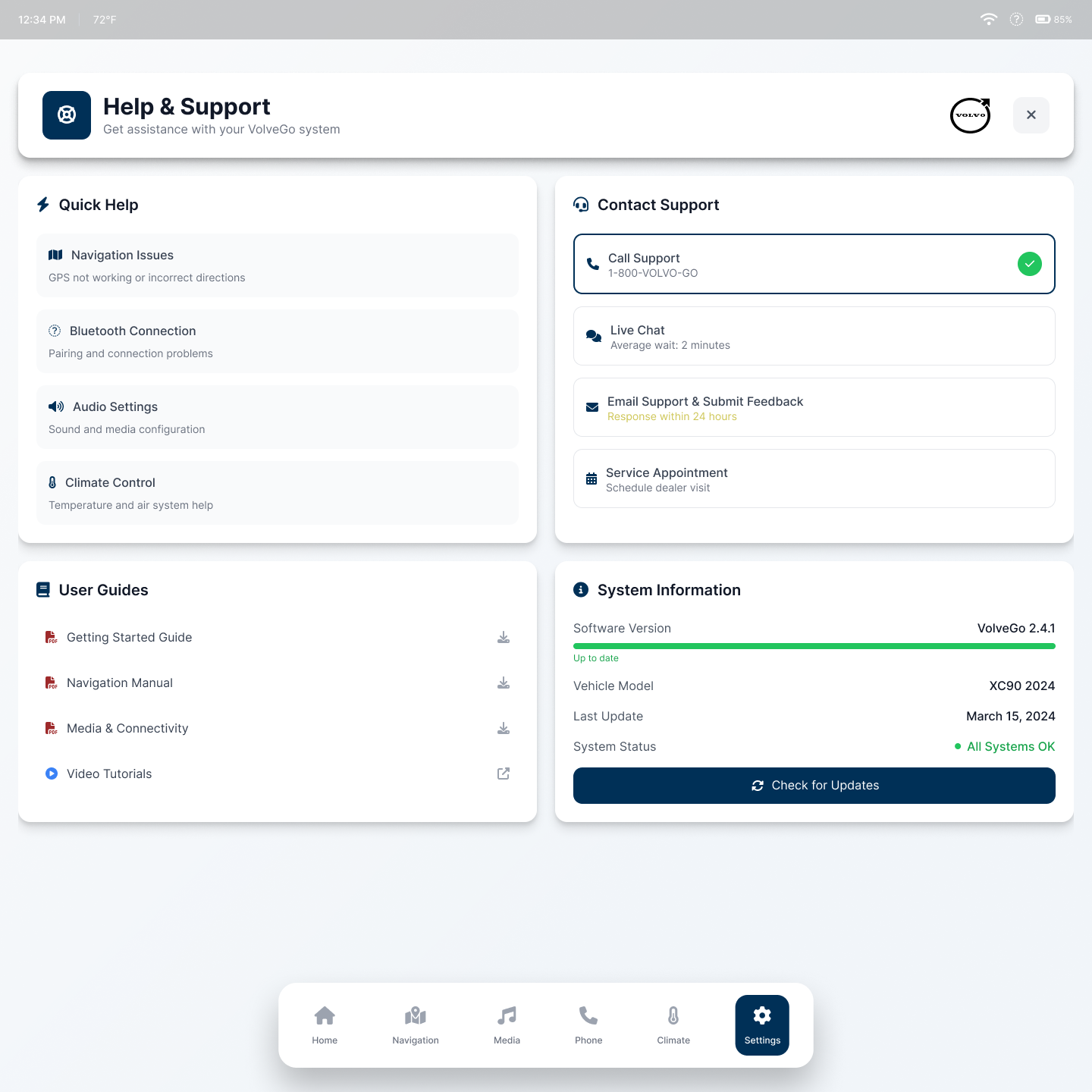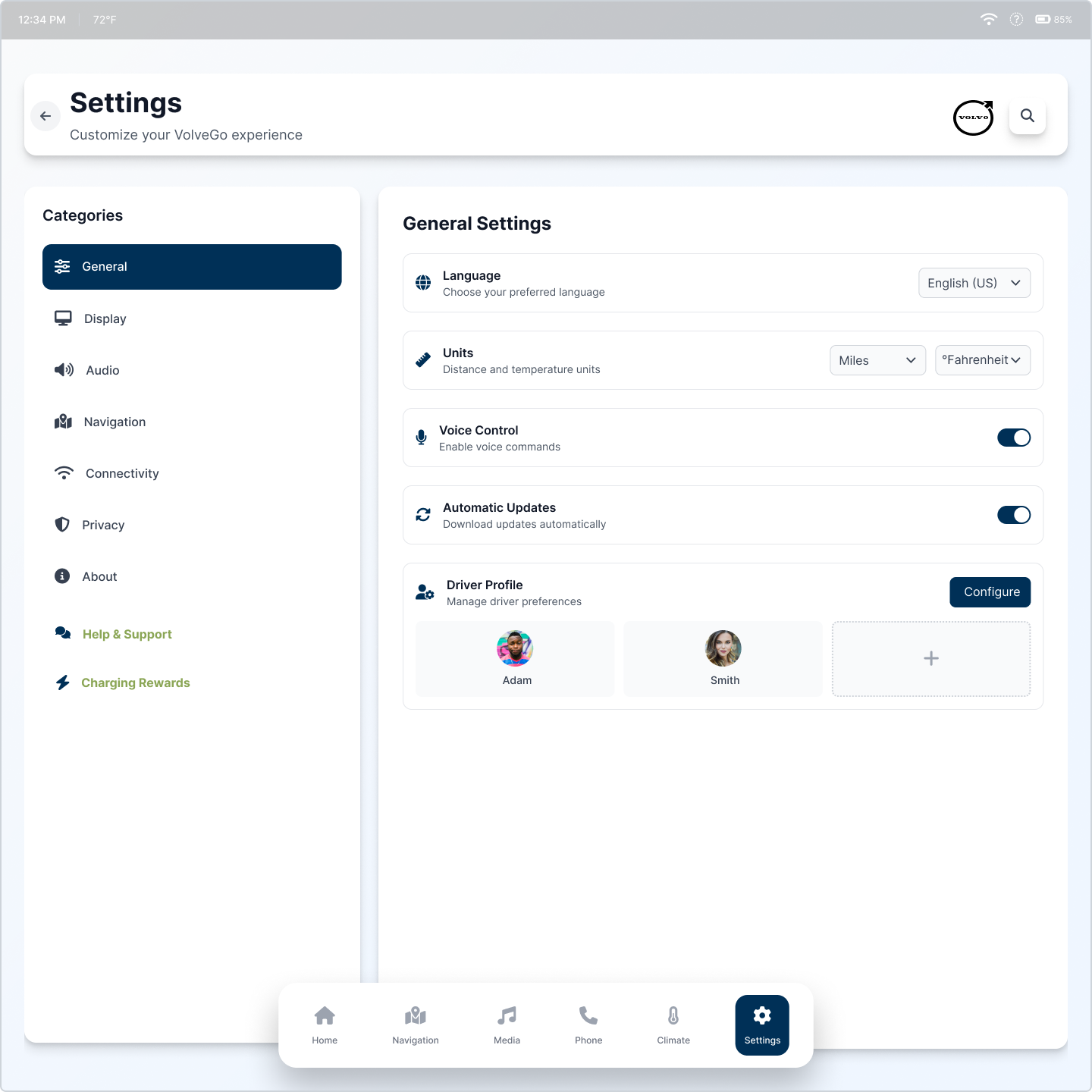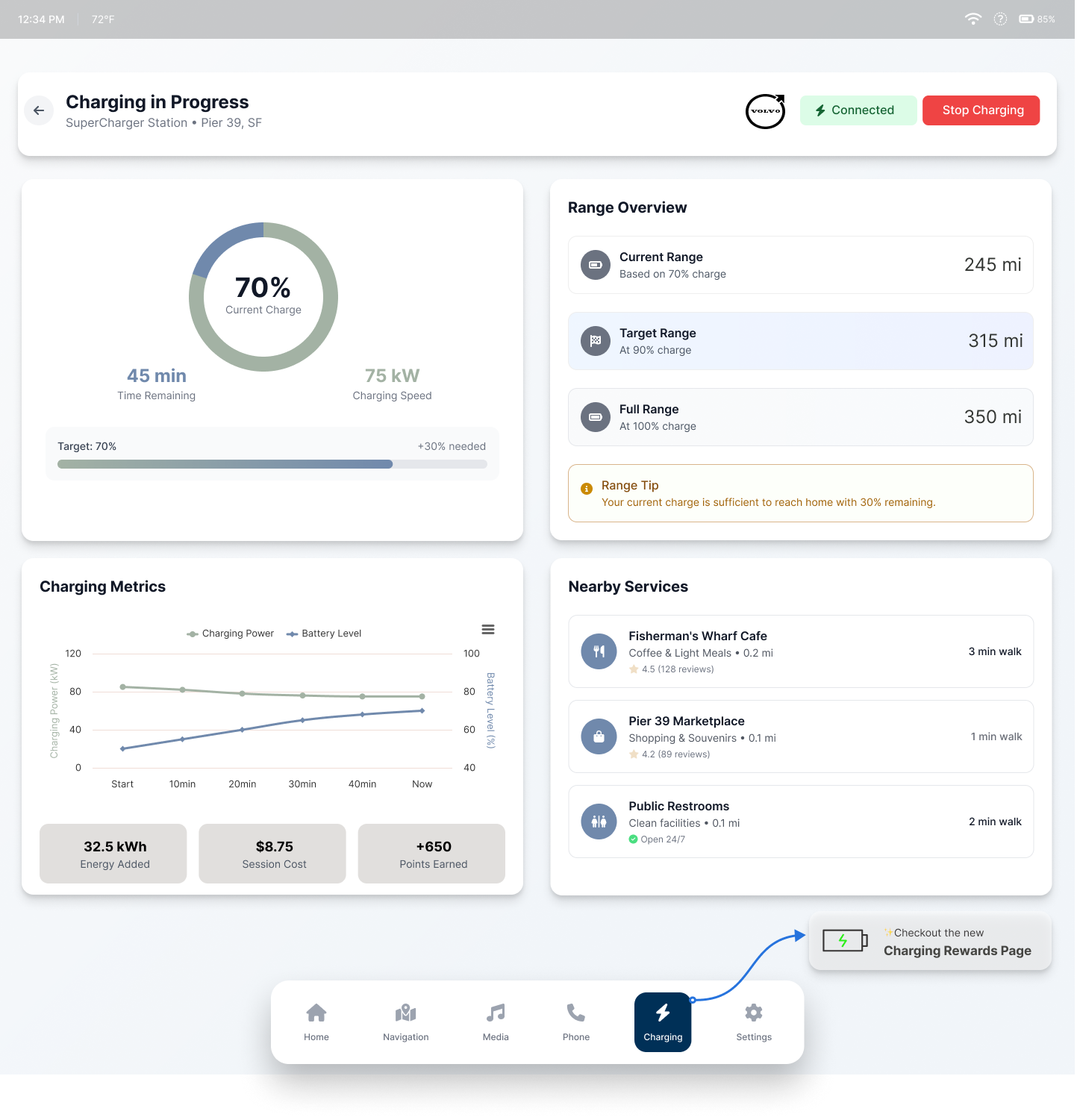Volvo Retention Drop-off Business Case
This business case outlines the process of validating the need to ship significant improvements to the core infotainment and mobile app experiences for the Volvo technology ecosystem. These improvements aim to enhance engagement, customer satisfaction (CSAT), and reduce feature bypass through Android Auto and Apple CarPlay. The ultimate goal is to address the 68% retention drop-off reported, post-launch.

Table of Contents
- Overview
- Volvo Automotive Division - Mission Statement
- Problem Statement
- Market Research
- Measuring Success (Metrics and KPIs)
- Features and Prioritization
- Prototype Infotainment Views
- Messaging and GTM
- Summary
Overview
The VolvoGo Mobile and In-car applications provide an intelligent way to assist our users in reducing their carbon footprint. Core features include locating mobile charging networks, optimized trip planning, destination check-in, turn-by-turn routing, and integrated payment processing. All functions are available cross-platform through your VolvoID, which ensures seamless access and interoperability across the entire Volvo technology ecosystem of connected services.
After our successful initial launch, our analysts and product teams observed a significant degradation in the value proposition for our core services. Specifically, retention, measured as engagement with the charging and routing features, dropped off substantially after the first month of use. VolvoGo V2’s main objective is to address the need for an optimized, fault-tolerant experience for vehicle routing and charging. The goal is to improve user retention, drastically reduce feature drop-off, and increase overall engagement with the core services through digital-first solutions and enhanced customer support features to improve onboarding and remove complexity from the onboarding process, for both younger (≤ 45) and older user groups (≥ 45).
Volvo Automotive Division - Mission Statement
Volvo Cars’ purpose is “to give people the freedom to move in a personal, sustainable and safe way.” This is reflected in our ambition to become a fully electric car maker and achieve net-zero greenhouse gas emissions by 2040.
Problem Statement
Based on product discovery, which included synthesizing data from user research, product analytics, and qualitative customer feedback, we've identified a critical systemic failure post-V1 release: Significant feature drop-off after the second month of ownership, for both new and used machines.
The core issue is that user preference is shifting to Android Auto and Apple CarPlay for newer vehicles, bypassing our proprietary infotainment features. Data segmentation reveals a stark contrast in engagement:
Older demographics (72% drop-off): Based on EV OEM app data, older cohorts typically under-engage due to onboarding complexity and range anxiety (Tesla, GM, Volvo survey data, 2023–24).
Younger demographics (58% drop-off / 4 weeks): Consistent with high initial curiosity and lower sustained engagement when UX friction persists.
The technical impact is severe: Session-to-session retention dropped by 20% after two weeks. The funnel collapse is evidenced by the data; "Of 30,000 users who initiated a charging optimization route in Week 1 of vehicle ownership, only 9,600 did so in Week 2, 68% drop.”
Re-engaging users for the vehicle routing and charging experience is a dual challenge: It is a behavioral issue (lack of confidence, friction) compounded by a product reliability issue (sub-optimal UX/CX). The solution requires a combination of improved technical implementations, feature development, robust user onboarding flows, and continuous outreach to re-edify users around maximizing their charging and range optimization features.
Opportunity Hypothesis
We hypothesize that the most effective strategy to re-engage users with the vehicle routing feature sets is to introduce a re-designed, frictionless experience centered around behavioral economics. This will include a gamified experience to better incentivize user engagement with vehicle routing, range optimization, and the integrated charging feature sets.
A concurrently shipped improved Customer Experience (CX) strategy will include a newly designed help view within the infotainment and mobile app experiences. This will serve to better onboard older demographics and provide a more accessible, context-aware explanation of complex features.
Given the high reported overall user sentiment towards the Google Assistant integration in the Volvo Infotainment system, V2 will prioritize leveraging the voice assistant API to integrate seamlessly into the new features. This API-first approach is projected to delight our current promoters and mitigate friction for potential infotainment/Mobile detractors.
Market Research
Volvo Cars has hit a major inflection point in its journey toward becoming a fully electric manufacturer, delivering its one millionth Plug-in Hybrid (PHEV). This milestone isn't just a number; it validates a successful transitional product strategy and provides key insights for future EV development and adoption.
The rapid scaling of the hybrid segment from 46,000 units in 2019 to over 177,000 in 2024 shows strong market readiness and consumer acceptance for electrified powertrains over traditional internal combustion engines (ICE).
In 2024, electrified vehicles (Full EV and PHEV) made up 46% of Volvo’s worldwide sales for the automotive division, which has signaled a clear, accelerating shift in consumer preference. This included a 54% surge in full EV sales and 16% growth in PHEV sales, year over year.
Market Research Takeaways & Product Opportunities:
• PHEV as a Bridge: PHEVs accounted for 23% of global sales in Q1 2025, demonstrating their position within the market as a critical "bridge" product to full electrification.
• Segment Leadership: Volvo maintains the highest share of PHEV sales among all legacy premium brands, underscoring product positioning and market dominance in the premium hybrid space. The success of the XC60 and XC90 offers a framework for successful powertrain transitions within the premium segment.
• Operational Insights & Feature Development: Company data shows PHEVs run on electric power for approximately 50% of their driving time. This metric is a prime target for feature improvement (e.g., enhanced geolocation-based charging, optimized power management software) to maximize electric-only usage, and aligns with many of the key objectives outlined as part of the V2 retention and engagement initiative.
Measuring success
The success of VolvoGo V2 Retention Initiative will be measured against engineering, product, design, and operational metrics, with the focus on technical/ engineering success metrics.
| Metric / KPI | Target | Measuring Success (Technical & Product-Focused) |
|---|---|---|
| P1: Week 2 Retention (Core Action) | Reduce drop-off by ≥ 30% (Current 68%) | Cohort Analysis: Track the percentage of users initiating a route in Week 1 who initiate any routing/charging session in Week 2. |
| P2: Charging Feature Stickiness | Achieve a Stickiness Rate (DAU/MAU) for the charging view of ≥ 20%. | Product Analytics: Calculate (Daily Active Users in Charging View / Monthly Active Users in Charging View) × 100. |
| P3: Routing Service Failure Rate | Achieve Trips Performed without Failure ≥ 99.5% | System Telemetry: Track API call success rate for the route optimization microservice and charge point availability checks. Measure latency for route calculation. |
| P4: PHEV Electric Mode Utilization | Increase Electric Mode Distance Share for older demographics by ≥ 15% | Vehicle Telematics / Backend Data: Track the ratio of electric-only miles/km driven to total miles/km driven, segmented by age cohort. |
| P5: Onboarding Conversion Rate | Achieve a 70% completion rate for the new CX / Onboarding flow. | Funnel Analysis: Track user drop-off points within the new guided help views and gamified tutorials. |
| P6: Charging Confidence Score (CX) | Improve charging confidence scores from user surveys by ≥ 25% | A/B Testing / CX Surveys: Implement post-trip or post-charge micro-surveys targeting new users. |
| P7: CSAT / Infotainment Sentiment | Achieve a CSAT ≥ 90% within 3 months post launch. | Voice of Customer (VOC): Analyze sentiment for in-car features vs. third-party apps (Android Auto / CarPlay). |
| P8: Gamification Engagement | Achieve Daily Task Completion Rate ≥ 40% | Product Analytics: Track conversion rates for daily/weekly challenges (e.g., charge within optimal window, use voice command). |
| P9: AOV (Charging) | Achieve an AOV increase of 16% over 6 months. | Payment Gateway / Transaction Data: Monitor revenue generated from integrated charging sessions, correlated with gamification points/rewards. |
Features and Prioritization
The features are prioritized using the MoSCoW method, focusing first on Must Have items that directly address the root causes of the 68% retention drop-off (usability, reliability, and feature bypass).
| Category | Feature Name | Technical Description & Retention Impact |
|---|---|---|
| MUST HAVE (Make-or-Break for V2 success) | 1. Predictive Range & Charging Reliability Engine (AI/ML) | Technical Fix: Integrate real-time/predictive data sources (ML models) for charger availability and range estimation, considering road topography, weather, and driving style. Impact: Directly mitigates "range anxiety" and fixes the core routing failure causing 68% Week 2 drop-off. |
| MUST HAVE | 2. Voice Assistant API Integration (Google Assistant/Gemini compatible) | Technical Requirement: Develop robust, reliable backend APIs to fully expose V2 routing and charging functionality to the Google Assistant layer/Gemini. Impact: Directly addresses user preference for voice control and competes with third-party systems (CarPlay/Android Auto) by making the native system seamless. |
| MUST HAVE | 3. Contextual, Segmented CX Onboarding Flows | Technical Requirement: Implement a headless CMS for in-app help that serves dynamic, targeted tutorials (e.g., explaining PHEV electric-only mode) based on user segment (age/vehicle type) and feature drop-off behavior. Impact: Directly addresses the high drop-off and lack of activation for older demographics. |
| SHOULD HAVE (High Value, essential for long-term retention) | 4. Gamified "Eco-Drive" & Charging Achievement System | Technical Development: Build a dedicated gamification microservice with event-based logging to track key actions (e.g., efficient routing, optimal charging window). Implement points, badges, and a leaderboard visible in both the mobile and in-car app. Impact: Provides behavioral incentives to drive engagement, improving Stickiness Rate (DAU/MAU) and usage for younger demographics. |
| SHOULD HAVE (High Value, essential for long-term retention) | 5. Seamless Payment and Reservation Interoperability | Technical Improvement: Standardize payment APIs (e.g., via OCPP / ISO 15118) to enable one-tap or automated charging session initiation and payment across multiple Charge Point Operators (CPOs). Allow for pre-booking of chargers via mobile and infotainment. Impact: Reduces transaction friction, increasing AOV and charging session completion rate. |
| COULD HAVE (Nice-to-Have, valuable if scope allows) | 6. Advanced Personalized Recommendation Engine | Technical Development: Utilize user charging history and location data (AI/ML) to proactively suggest charging stations based on preferences (e.g., fastest charger, cheapest charger, amenities nearby). Impact: Enhances the user experience beyond core functionality, boosting CSAT. |
| COULD HAVE (Nice-to-Have, valuable if scope allows) | 7. Community Forum / Referral Integration | Technical Integration: Implement an SDK or API for a community platform to allow users to share achievements, tips, and referral codes. Impact: Leverages social proof and competitive drive for increased long-term engagement and user acquisition. |
| WON'T HAVE (Future scope) | 8. Dynamic Pricing & Energy Grid Optimization | Technical Strategy: Highly complex integration with energy grid APIs and dynamic pricing models to suggest charging at off-peak hours for lowest cost. Impact: High effort, not critical for addressing immediate retention/V2 core feature drop-off. Defer to V3. |
Prototype Infotainment Views
Of the eight main features being proposed, the design will prioritize the new views requiring the most front-end and design deliverables. These include the new gamified charging experience, the charging-in-progress view, the improved settings view, and the optimized Google Voice Assistant experience, which displays a chat modal during a routing event for context. The new settings view will allow users to submit feedback, contact support, or read infotainment documents in-car and parked. These features are crucial in determining the overall success of this initiative. For the sake of this business case, we have decided to deprioritize introducing the corresponding mobile views and experience to focus on the problem space.
Enhanced Voice Assistant
Google Voice Assistant is expanding its capabilities with enhanced backend support, enabling it to seamlessly integrate across the entire infotainment experience. This integration leverages Gemini, offering users an ultra-modern chat and voice interaction experience in their vehicles.

Newly designed Help and Settings View
This new experience aims to enhance the user experience for both targeted demographic groups by providing easier feedback submission, access to informative resources, direct support contact (when available), and more.
New users will be introduced to this system through a guided onboarding experience, which will be an optional feature available via a pop-up notification from every view for the first two months of ownership. The frequency of these pop-ups will gradually decrease as users approach the two-month mark. Users can also disable this feature from the Settling View.

Volvo Charging Rewards View
This innovative approach introduces gamification into the infotainment to motivate users to optimize their EV charging, minimize their carbon footprint, and earn rewards for their participation.

Optimized Settings
The newly implemented Settings view is designed to provide a more customizable experience, as per all the feedback gathered during user research. It allows users to enable or disable critical functions within the view and more.

Charging In-progress View
This is the newly introduced view that offers an enhanced experience while charging, navigating to nearby stores, viewing charging metrics, and accessing the charging rewards view.

Messaging and GTM
The VolvoGo V2 GTM strategy focuses on behavioral re-engagement(the main pain point this initiative will be solving for), technical reliability, and clear user education across both of the primary demographic user groups: younger and older demographics. Campaigns will emphasize the themes of Reliability, Simplicity, and Optimized Electric Driving, aligning with Volvo’s mission to deliver a sustainable and intelligent mobility experience.
Messaging will highlight the gamified charging experience for younger demographics, emphasizing achievement systems, charging optimization, and seamless Google Assistant integration. For older demographics, campaigns will focus on confidence-building and guided education, using personalized outreach to encourage full EV utilization and comfort with new digital-first features.
Outreach will span multiple channels, including email, push notifications, in-app tutorials, dealership touch-points, and outbound support, ensuring users understand how to maximize infotainment features. Volvo dealerships will receive dedicated training assets, including video and internal micro-sites, to support onboarding, while a coordinated press and partner launch will reinforce Volvo’s long-term digital-first innovation strategy to compete with EV companies that have championed this ideology as part of their ethos from inception.
Summary
If you have parsed through all of this content to this point, I truly thank you; I thank you for taking the time to learn more about my work and how I approach solving product problems. This business case is a follow-up from VolvoGo, which was initially shipped in 2019. Check out the original VolvoGo case study.
This business case, case study, will have one or two follow-up posts that delve into a detailed technical implementation. These posts will cover topics such as the microservices approach to systems architecture, API-first software dev, and using a headless CMS to target and serve demographic-specific onboarding content to users, among other technical implementations as part of the overall scope of work.